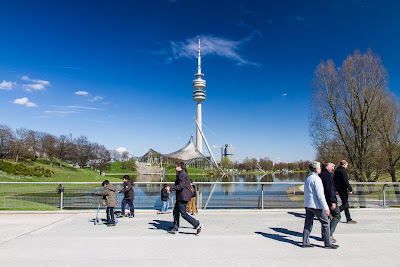The filters enhance the blue colour of the sky providing a powerful deep blue, and at the same time taking away the glare from the water's surface. Sure there is a price, 2-3 stops of light are lost, but generally when such a filter is needed, the light level is already very high. Otherwise, shifting to ISO 200 or 400 solves the problem as does an image stabilized lens.
There is, however, a down side to these filters. In the tropics we expect to see a deep blue sky, in Northern Europe the affect can be too pronounced and the look from many polar filtered images looks false, the blue often has a chocolate box quality. There is also a risk of a colour caste if the filter is not of good quality. Finally, once used the affect of the filter is part of the digital negative. With my most recent cameras the sensor dynamic range is generally good enough that I do not need the filter, I can handle the adjustments later in software, preserving the integrity of the digital file. Since starting this course I have actively avoided using a pol filter for the above reasons, however, this weekend I gave it a go once more.
I spent both Saturday and Sunday attempting to capture some images evoking spring for my portfolio. Heidi and I also took the train down to the alps for an afternoon walk and a sampling of Tegernseer Hofbrau Bier at the "Herzoglich Bayerische Brauhaus Tegernsee", a monestary founded in 746 and brewing some of the best bier anywhere in Bavaria and thus the world!
First task of the day was to take a couple of shots of the lake with the pol filter rotated to lightest and drakest settings:
Unfortunately, not the best day for such comparisons, too much hazy cloud and the sun was already very high, however, the affect of the filter can already be seen in these two images. The water, however, showed a much more pronounced difference:
Here there is a clear difference between the two files, the polar filter really cutting through the water. Conclusion is that the polar filter is a useful tool, however, these experiments were not terribly convincing due to the weather at the time. The following day was going to be clear blue sky. I will return to this later.
First a quick commercial on behalf of a truly beautiful place only 60 minutes by train from Munich, This is the town of Tegernsee:
And the brewery/abbey/school/beer garden/ beer keller. The Germans do multi-functional buildings very well, and beer is considered very close to God.
Not the best of days for photography, but Sunday, wow...
Cold, but very clear, much better conditions to play with my polar filter. The following two images show the affect of the filter on the water, but not to good affect, the green algae at the bottom of the lake is not very attractive, the image without it is much better.
When I started this commentary I mentioned the problem that a polar filter can over egg the pudding, creating far too much blue:
Both of these images would have been better without the filter, the blue is too deep. I can correct this in processing, however, I would be better to add it into the image rather than try to take it out. I have mixed feelings about these filters, used carefully they can enhance an image, but too often the effect is too strong.












No comments:
Post a Comment